Affiliate disclosure: This post may contain affiliate links. Please see our Privacy Policy.
Salt cured duck breast is one of the easiest dry-cured meats you can make. The basic recipe only requires duck breast and salt, but you can fancy it up with spices any way you choose.
Unlike many cures that can take months, this duck prosciutto recipe only takes about a week start to finish.
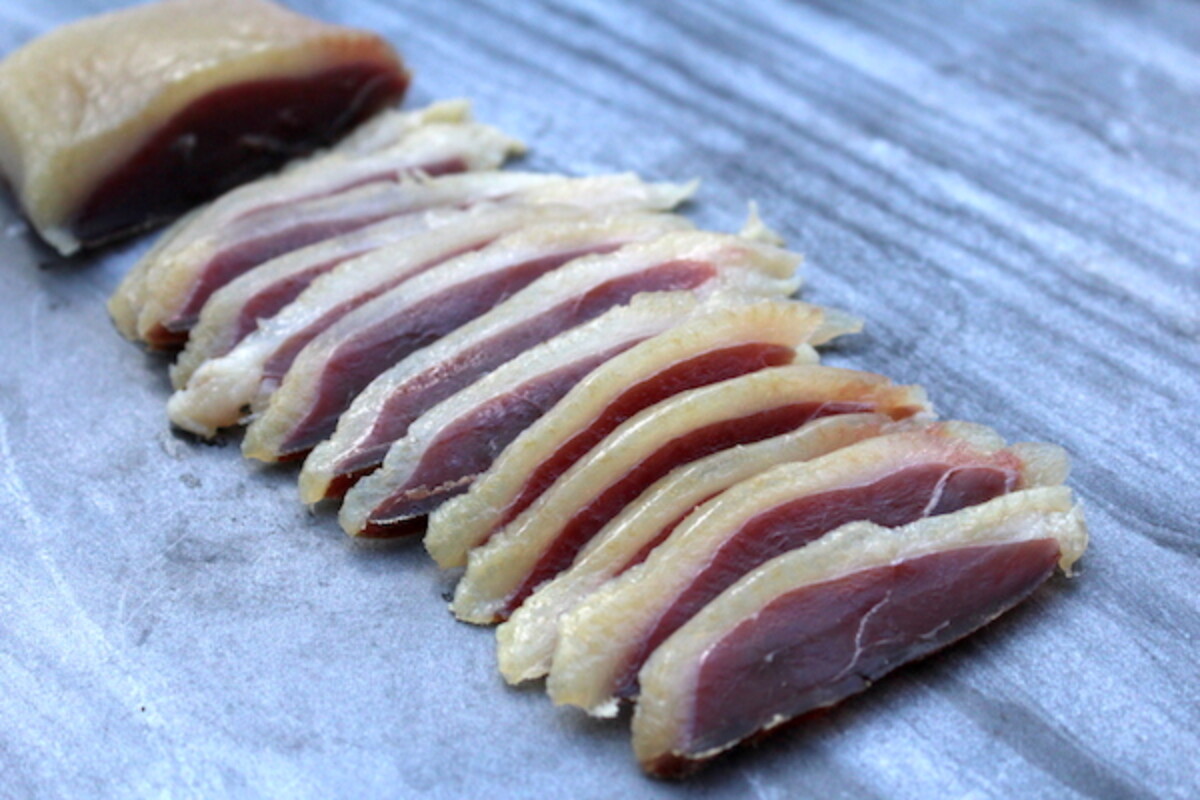
Let’s face it, old school methods of food preservation without refrigeration can be a bit intimidating. How many times have you been warned to keep meat refrigerated, and there’s always someone at a potluck worrying about a bowl of potato salad that’s been out of the refrigerator for a bit too long.
Then there’s charcuterie, where you’re asked to take a piece of meat and hang it to without refrigeration for weeks or months at a time. Trust me, it’s worth it.
What is Duck Prosciutto?
Technically, duck “prosciutto” isn’t really prosciutto, but it’s used in the same way. If you’re an Italian charcuterie purist, you’d associate prosciutto with salt-cured meat made from the hind leg of just about any animal, but most often pig.
Lamb prosciutto is also a thing, and even on occasion goose prosciutto, made from a salt-cured goose leg. Duck legs are pretty small, even on large domestic birds, and the term duck prosciutto refers to a salt-cured duck breast.
According to the Center for Jewish Studies at the University of Washington, the tradition of duck prosciutto comes from the Jewish community in Italy and Spain. Pork prosciutto obviously isn’t kosher, but it’s a huge part of the Mediterranean culture, and salt-cured meats were essential for survival before the advent of refrigeration. The practice is centuries old, and there are references to “Jewish ham” or duck prosciutto in literature dating back to the time of the inquisition.
Whether you call it duck prosciutto or salt-cured duck breast, no matter. It’s still delicious. Slice it super thin and serve it with all the same fanfare and accompaniments that go well with pork-based prosciutto.
Try adding it to a charcuterie board with cornichons, melon, aged cheese and all manner of other cured meats. I’m hoping to serve it up alongside some of my homemade farmstead cheddar, which may not be traditional but the fact that both came out of my kitchen seems fitting.
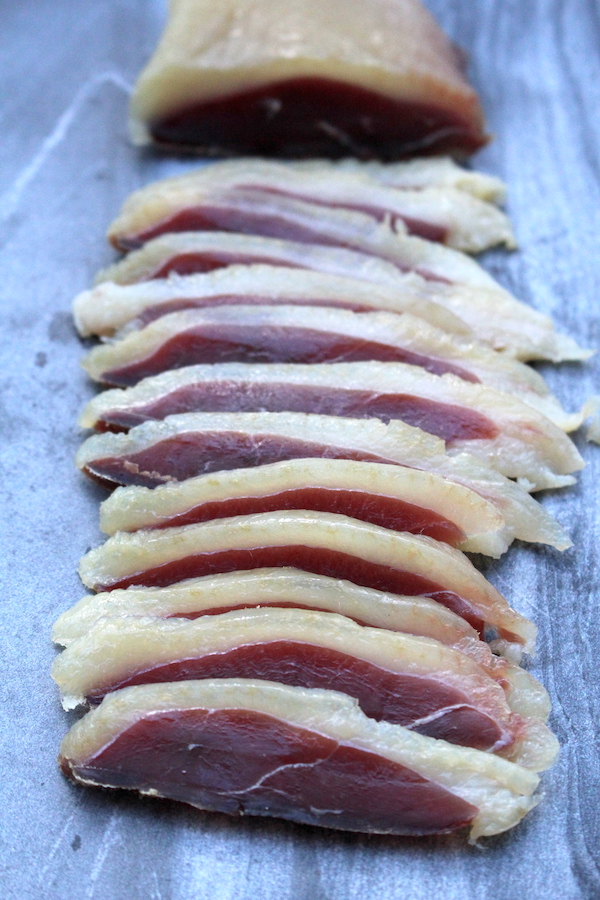
How Salt Curing Works
Salt-curing doesn’t prevent bacteria from growing in the meat, it just creates the right conditions for the right kind of bacteria. In a high salt environment, spoilage bacteria have a hard time taking over.
While they’re struggling, salt-loving lactic acid bacteria go to work. The same little beasties that are responsible for yogurt and sauerkraut are going to go to work on a piece of meat, quickly becoming the dominant organism.
Those same lactic acid bacteria then release a bit of acid, which lowers the pH of the meat and makes it even harder for spoilage bacteria to grow. It’s that same acid that gives yogurt its tang and sauerkraut a bit of vinegar kick. Inside of the meat, it creates incredible depth of flavor all the while effectively dry pickling the meat to prevent spoilage.
How to Make Duck Prosciutto
There are plenty of recipes for duck prosciutto out there, many of which require complex weights and measures. That’s because they’re using curing salt (nitrites), which requires specific concentrations. Just enough to be effective, but not so much that it’s toxic.
If you’re interested in curing duck breasts using curing salts, here’s a tested recipe with detailed instructions. The truth is though, adding nitrites for duck prosciutto isn’t strictly necessary and the recipe is much simpler without it.
When you’re just using salt and duck breast, the measurements don’t actually matter that much. In an ideal world, weigh the duck breast before you start, so you have a baseline to compare to when you finish, but even that’s optional.
Start by obtaining a duck breast. The simplest way is to just buy one, obviously, and many stores sell fresh duck breasts these days because they’re a wonderful date night meal.
If you start with a whole duck, it’s much cheaper, as whole ducks generally cost about 1/3 as much per pound as breasts purchased alone. You then get the added bonus of duck legs for confit and a carcass for a rich homemade duck stock.
To remove a duck breast, slide a knife along the breast bone to split the breast, and then run the knife under the breast to remove it. Trim the skin around the outside to separate the whole breast from the rest of the duck.
Michael Ruhlman’s recipe in his book Charcuterie: The Craft of Salting, Smoking, and Curing calls for 1 cup of kosher salt per duck breast. That’s more than is strictly necessary to get the job done, but too much is better than not enough.
There’s ample salt to completely cover the breast, which ensures good penetration all around the meat. Put about 1/3 of the salt in a non-reactive container, then add the duck breast and then cover the breast with the remaining salt.
Ideally, choose a container that’s not much bigger than the breasts, so you don’t have to waste extra salt. For a single duck breast, a ceramic or glass bread pan works well and was just right to hold one breast and one cup of salt.
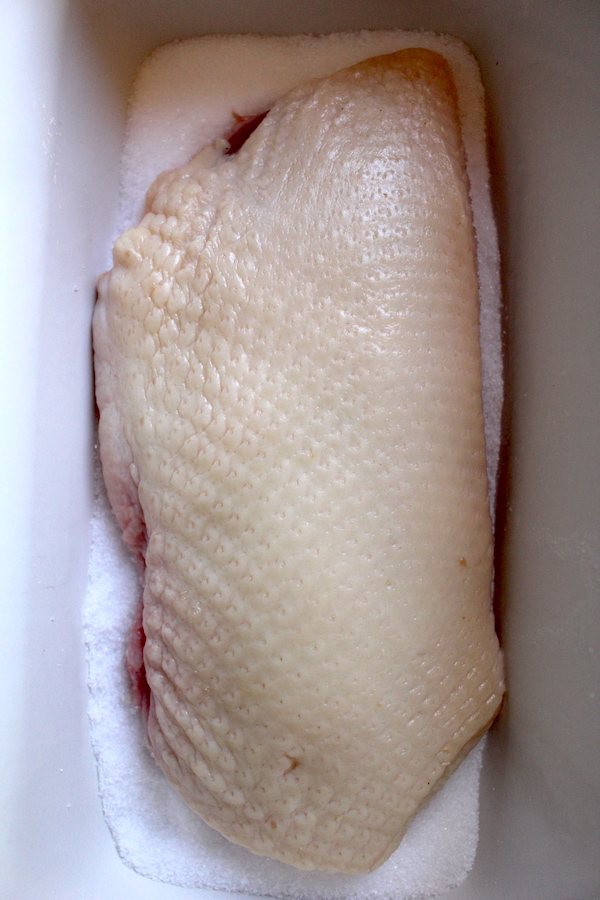
While weighing things isn’t strictly necessary, it does come in handy when scaling recipes. The duck breast I chose was just under 300 grams, and a cup of kosher salt was ever so slightly over 300 grams. So if you’re going by weights instead of measures, a 1:1 ratio of salt to meat is what I’m using here.
Weighing is also helpful in determining when the duck breast is done curing. Ideally, the cure will lose about 30% of its original weight, so my 300-gram duck breast should yield about 200 grams of finished duck breast prosciutto.
Allow the duck breast, completely surrounded in salt, to cure for 24 hours. Ideally in the refrigerator, since in these early stages, the salt hasn’t penetrated the meat and there’s more risk of spoilage bacteria taking hold. Since refrigeration is relatively new historically speaking, this cure would have taken place in a cool cellar or spring house.
After 24 hours, remove the breast from the salt cure.
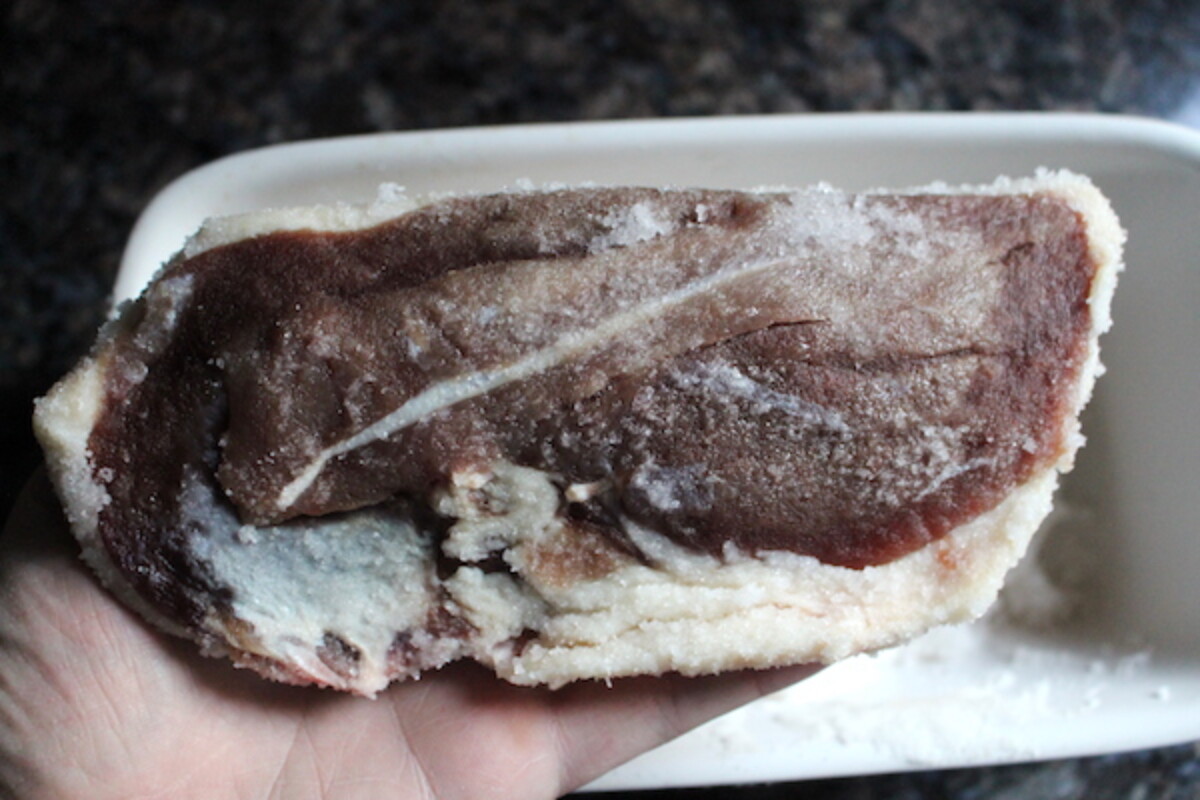
Once the duck breast is out of the salt cure, dust off the extra salt and give it a quick rinse in water. Pat the duck breast completely dry, and then wrap it in cheesecloth secured with butchers twine.
Hang the duck breast in a cool place to dry, ideally somewhere quite humid and around 50 to 60 degrees. Allow them to dry for about 7 days until they’re uniformly firm throughout (but not rock hard) and have lost 30% of their original weight.
If you live in a warm, dry environment I’d recommend building a curing chamber for best results, but here in Vermont, my basement has the perfect conditions year-round.
Once the dry time is over, you have a few options. For best quality, wrap the breasts tightly and store them in the refrigerator until you’re ready to use them. Or, just leave them to hang.
The longer the salt-cured duck breasts hang, the more “cured” they’ll taste as the lactic acid bacteria continue to work within the meat. The downside, however, is that they’ll continue to lose moisture. The first time we made salt-cured duck breasts, we just left them all hanging.
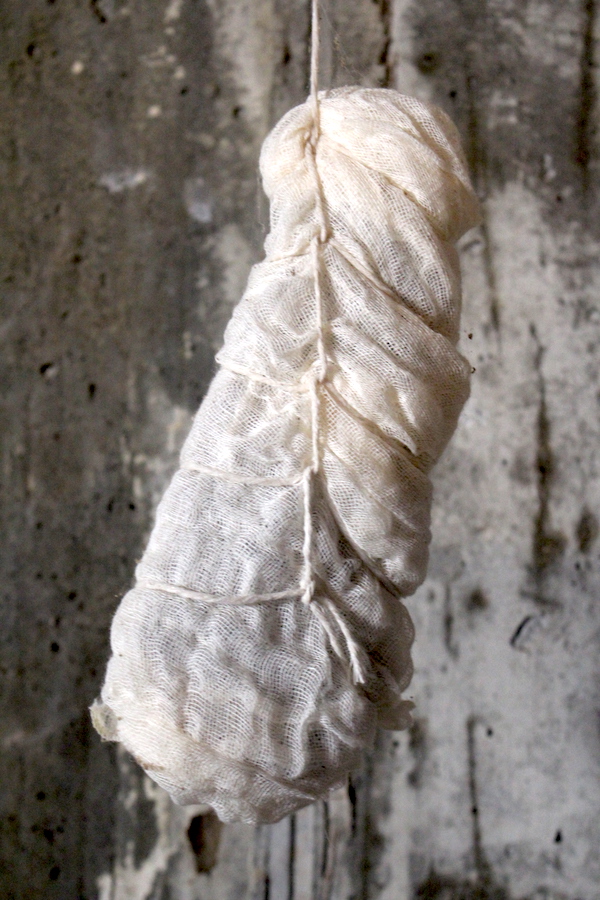
We had processed 8 ducks of our homegrown ducks in one day, so we salt-cured a total of 16 breasts. That turned out to be way too much to eat in a reasonable time even with very appreciative friends. If you have a consistently humid storage space, like a root cellar or cheese cave, they’ll hang for a long time continuing to improve in flavor without drying out too much.
Our basement is usually quite humid, but not quite humid enough to keep duck prosciutto from over-drying. At one week old they were supple delicious duck prosciutto. At about 6 weeks, they were rock-hard meat pucks.
While they were too hard to cut for a charcuterie board, they were still delicious grated with a micro-plane into a soup and as a salad topping.
Know that if you do leave them hanging too long, they’re still perfectly edible, though they may be too hard to cut. Just grate them up and add them to a long slow-cooked soup, or use them like an umami-filled parmesan topping finely grated onto fancy dishes.
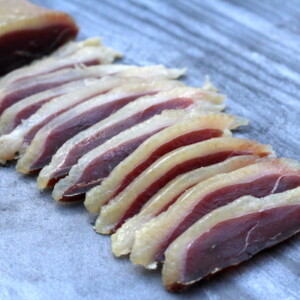
Duck Prosciutto ~ Salt Cured Duck Breast
Ingredients
- 1 duck breast, about 300 grams
- 1 cup kosher salt or pickling salt, about 300 grams
- Seasonings if desired, pepper, juniper, bay, etc
Instructions
- Place 1/2 cup of salt in a non-reactive container. Place the duck breast on the salt, and bury it in the remaining half cup of salt. (use more if necessary, to completely bury the meat).
- Allow the duck breast to cure in the salt in the refrigerator for about 24 hours, until the texture is firm. If it's still squishy like raw meat, put it back in the salt and give it a few more hours.
- After the salt cure is complete, remove the duck from the salt, brush it off and give it a quick rinse in running water.
- Pat the duck breast dry, wrap it in cheesecloth and hang it to dry in a cool place for about 7 days until it loses about 30% of it's original weight.
- Once the drying is complete, wrap the breast tightly to prevent further drying and store in the refrigerator until ready for use. Slice very thin, and serve like traditional prosciutto on a charcuterie platter.
Notes
More Traditional Salt Cured Foods
Ready to learn more about traditional salt curing? Read on…
- Salt Cured Egg Yolks
- Salt Cured Pork Jowl (Guanciale)
- Salt Preserved Lemons
- How to Preserve a Whole Pig Without Refrigeration
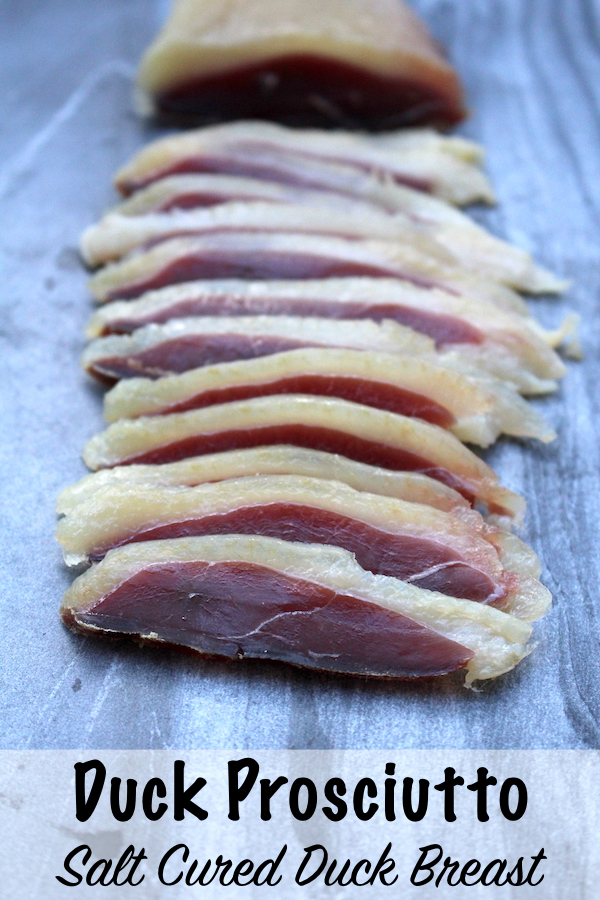
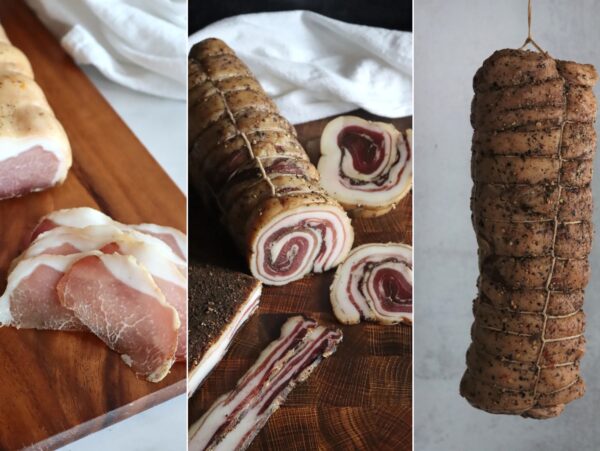
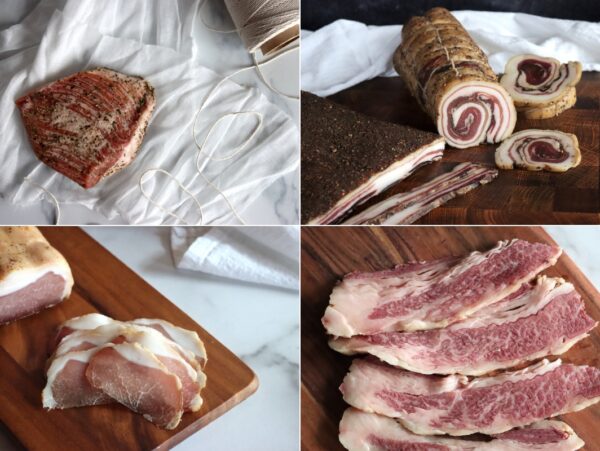












I’m very interested to try but how can I make it with whole duck? Should I remove the bones first?
The breast is typically used because there is more meat on that part of the bird. You could certainly try it but you would definitely want to remove the meat from the bones.
Just a few tips from a veteran charcuterie chef on curing duck breast, please don’t reuse the salt. I prefer rinsing the duck off with white wine or beer, adds more flavor and your not adding water which is what we are trying to remove. .Before you wrap the duck in cheesecloth coat the meat side of the duck breast with lard or duck fat, this will stop the edges of the meat drying out and give you more yield. Ruhlman books are good but a bit loosey goosey on measurements “the art of charcuterie” is a great book and very technical. Percentage cures are more accurate and repeatable!
Thank you so much for sharing.
I’ve been following a different recipe that calls for leaving it hanging 14-18 days (also in the fridge rather than elsewhere). I’d rather only have to wait a week but is there a way to really tell for sure that it’s done curing? I’m willing to wait longer and not accidentally eat partially raw meat
I am assuming that since you’re talking about it hanging that it is a different cut of meat than a sliced duck breast?
Hey I don’t have a good place in my house for that temp and humidity. Are there any alternatives, can I keep it in the fridge?
You can keep it wherever you want as long as you can maintain the proper humidity and temperature.
I have my duck breast drying and it’s been over 10 days but hasn’t lost but 20% of their weight. They are still soft enough to squeeze. So should I let them just keep drying until they hit the -30% mark? Thank you!
Yes, definitely let them keep drying, sometimes it takes a while.
Can I use frozen duck breast that have been thawed. I can’t get fresh duck in my area.
Yes that should work just fine.
If preparing several duck breasts simultaneously can they be stacked with a layer of salt separating them?
I think you’re probably going to get better results if the air can move freely around each of the breasts.
Hello!
Can you eat this?
Yup, that’s the best part!
I followed the recipe and the duck turned out extremely salty, i saw online that I can soak it in water for few hours to take that edge off, but wonder if it’s gonna introduce bacteria to it or ruin it even in the fridge?
The result of this recipe is definitely quite salty, and the idea is that you’d slice it very thin and eat in small quantities (like prosciutto, which is also quite salty). If you find it too salty, the best option is to slice it small and use it in soups and stews, and then skip adding salt to the recipe since the preserved meat provides the salt.
Is it also incredibly dry and hard? In that case, you may have dried it too much. I’ve found it has a flavor much like prosciutto, and a salt level like it too, but if over dried it becomes kind of a salt brick. That might be the problem too.
Hope this helps!
This is encouraging and I’m taking mine out of the salt to hang today. Excited first time!
2 questions
1) it’s winter in Connecticut and often rainy. My basement ranges in temp from 46-68 F & humidity from 72-79%. Think this will be ok?
2) will mice crawl down the string and eat my prized duck? I have numerous traps out and am trying some odd cover contraption (upside down plastic flower pot between duck & attachment point of ceiling joist).
Thanks again for great recipe & guidance,
Not sure what to tell you about mice, since we’ve never really had that much problem with them (good hunting cats). The temp/humidity you have listed there should be good, some variation is fine, and that’s all within good ranges.
Here’s a possible idea. Treat the mice like squirrels,, thread the hanging rope through a tin pie plate bent like a funnel, grease the funnel…if they do climb down the string to the tin pie plate…they just might slide off. I see people do that to their bird feeder poles to keep the squirrels off…it might work😁
Is it possible to substitute duck breast for the leg (duck Maryland)?
Yes, Robyn. This recipe is for the breast not the leg.
Hi sorry I meant if I can use the leg instead of breast.
No worries, yes you can use the leg. Most traditional recipes do use the leg but the duck leg is so small that the breast is easier to work with.
I’ve done this and it was wonderful. I have, for quite a while, been looking for information on doing this with chicken breast, but have found absolutely nothing. What is your take on the matter?
Good question, and I don’t have a good answer, unfortunately. I think people shy away from it because the state of how chickens are raised these days, and the fact that they’re prone to carrying all manner of things. Ducks are generally raised in better conditions, simply because they can’t tolerate what a chicken can in terms of confinement.
I’ve seen this done with both duck and goose, but never turkey or chicken. Is there a good reason for that? I don’t know, unfortunately, but I’d guess it has to do with the likelyhood that they carry pathogens, but really I don’t know.
Perhaps chicken isn’t used because its flavor isn’t strong enough. Since chicken is very mild, the end result may only taste salty and not much else.
Thanks, I do a version of this and throw in some spices with the salt cure. Gently scoring the fat and allowing it to crisp on the fat side only until it is rendered about half way. I generally start with a cold pan and render on low.
It’s next level; crispy proscuitto.
And also thank for the egg cure recipe, just out of the salt today. I tried duck eggs for some extra richness.
Hello! I tried this recipe and have two questions. First, when I took the duck breast out of the salt I failed to see the step about rinsing it. Now my duck breast is finished drying and has a crust of hard salt on the outside. Should I rinse this off or leave it? Secondly, there was a lot of salt used in the initial cure. Is the salt able to be reused for curing more duck breasts or should it be thrown out after the first one? Thanks!
Good question. Personally, I’d try to dust it off. I assume it’s pretty dry, and you should be able to more or less tap/brush it off. If not, try washing it off, then thoroughly drying the breast. With all that extra salt on there for an extended period, you might find that your breast is very dry and quite salty.
If it’s not good in slices, you can grate it very fine as a salad topper. I did that with a batch that I left hanging way too long. They dried into bricks, but a micro-plane meant they were super tasty grated.
As to re-using the salt, opinions are a bit mixed on that. Personally, I don’t out of an abundance of caution, but some people say they do. I’m honestly not sure what the risks may be of re-using it. I imagine if you put another one in right after you take out the first then it’s pretty well fine with no issue, but if you’re storing it, or re-using it many times then I couldn’t say.
Use your best judgment? It’s your health, and personally, salt is wicked cheap and though it may be wasteful, I’m not willing to risk some form of food poisoning over it. Sorry I don’t have more definitive advice for you.
i’m not qualified to give advice on this but I think that if you heat it up in a pan (toasted salt?) and maybe pass it through a sieve it would be fine to use